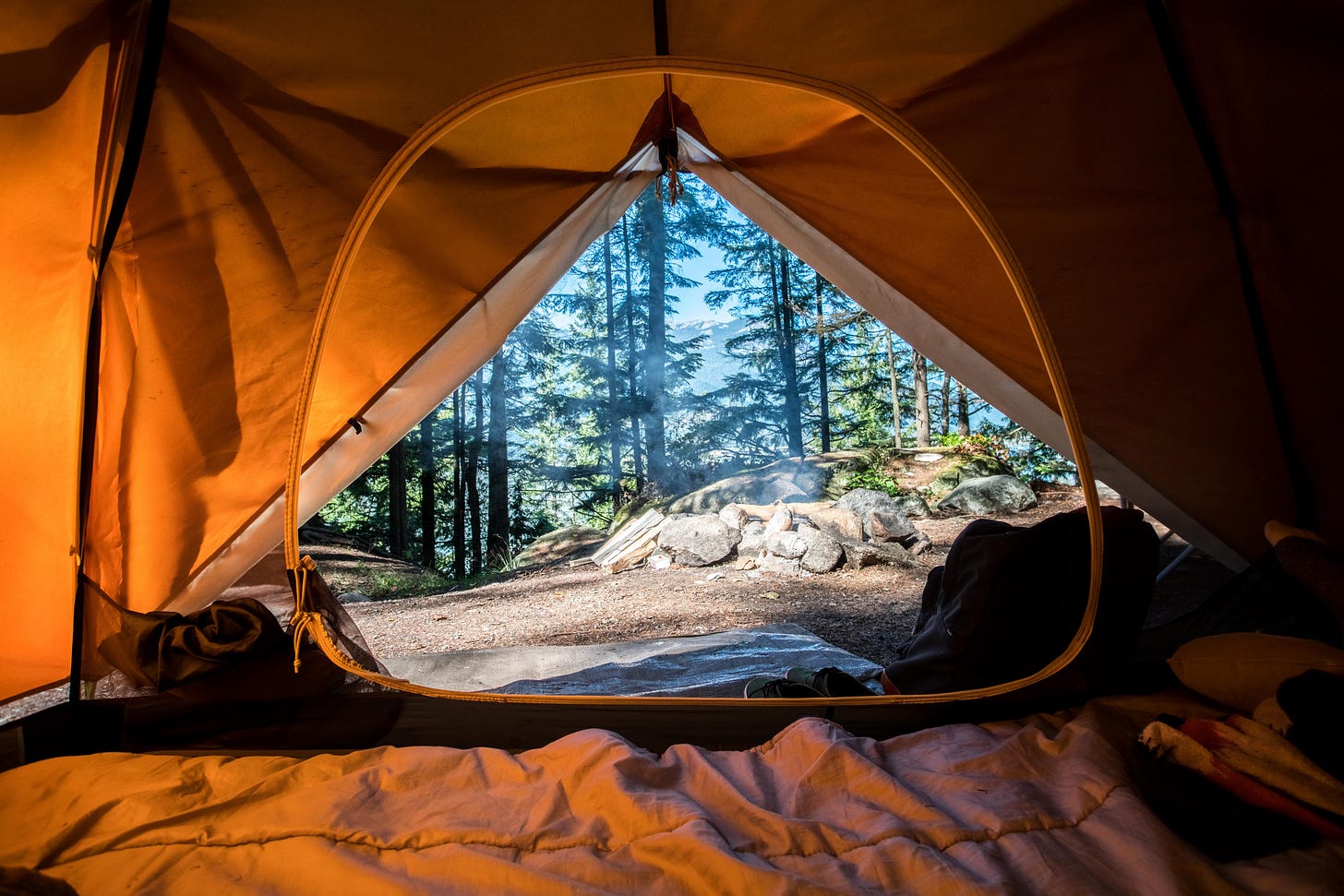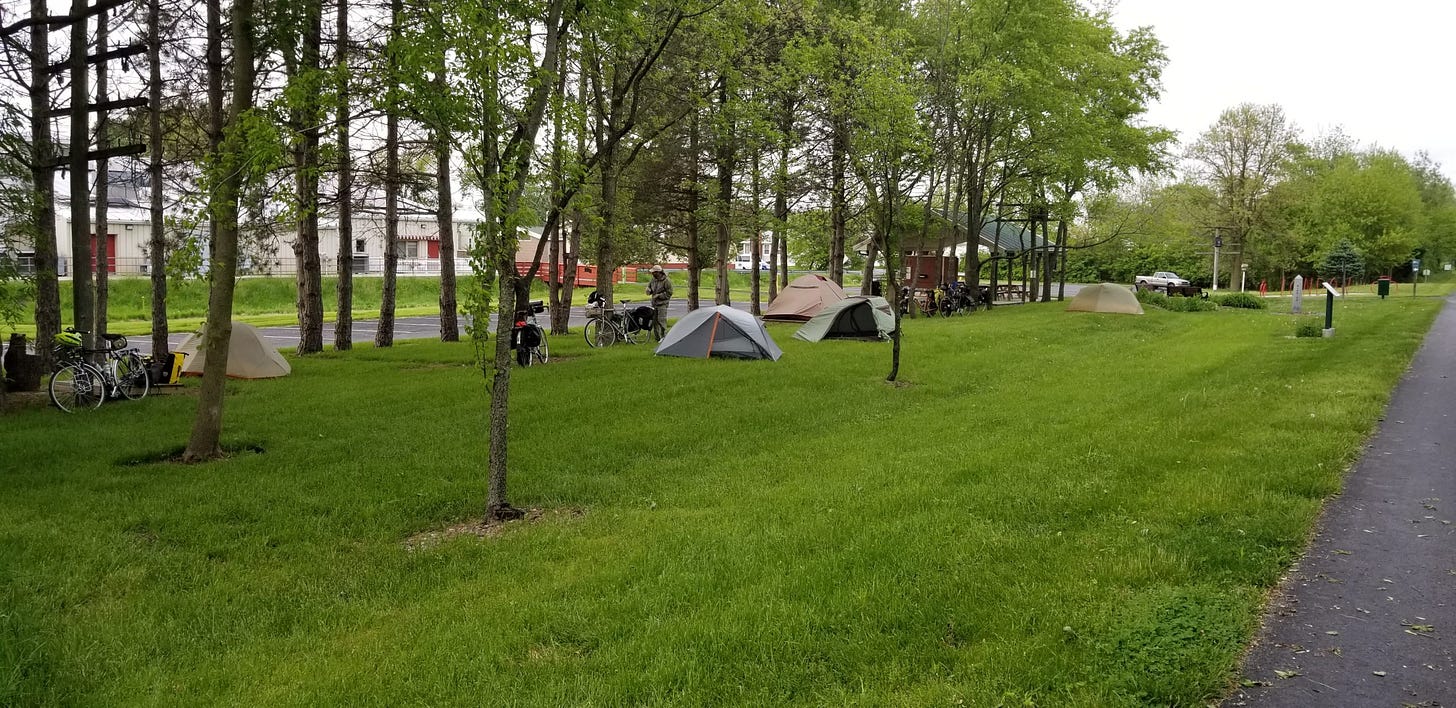Camping on your cross-Ohio adventure
Let’s talk about camping along the Ohio to Erie Trail

Camping is a piece of bikepacking and touring by bicycle for many people. This is the reason that the Ohio to Erie Trail includes a list of campsites near the trail on its website. The trail’s interactive map includes an OTET Campsite layer. The paper trail guide includes a list of campgrounds.
Questions the trail often gets are “Why are there not more campgrounds on the trail?” and “Where is camping permitted along the trail?” Let’s look at the accessibility of camping along the trail and some of the factors that come into play regarding where and why camping is permitted, not permitted, or unavailable.
Stealth/wild camping
Stealth camping is the practice of camping where it is not explicitly permitted. It is not allowed on the Ohio to the Erie Trail. I am not aware of an Ohio multi-use trail that permits stealth camping along the trail corridor. This is common in most long-distance trails such as the Katy Trail and Great Allegheny Passage.
A typical rail-trail corridor is 66 feet wide with a 10-12’ trail and 2’ limestone or grass shoulders. The remaining 50 feet of the right way (25 feet on both sides) typically has drainage ditches and are elevated to prevent flooding. It is often not clear of vegetation and fallen trees. The right of way is not a place to camp.
Trails aim to be good neighbors. This entails respecting neighbors' property, respecting nature, and leaving no trace. Stealth camping can damage the environment by trampling vegetation, creating erosion, disposing of waste improperly, and introducing invasive species.
Why aren’t there more primitive campgrounds along the trail?
Cost, space, zoning, regulations, maintenance, and community concerns are the primary factors. Trail organizations operate on limited budgets. Establishing a campground comes with up-front and ongoing maintenance costs that the trail may not be able to afford.
As mentioned in stealth camping, trail corridors are 66’ wide limiting the space to construct a campground. Locations of former railway stations and sidings can overcome this space constraint. However, land along the trail may be under private ownership and unavailable for campground use.
Local government may have laws restricting where primitive camping is permitted. Zoning regulations may restrict the location of campsites. Local laws and zoning aim to limit noise, assure neighbor privacy, and assure the safety concerns of residents.
Primitive campgrounds must adhere to health department regulations such as access to potable water and restrooms. These laws are designed to protect the environment and the safety of the camper. The trail may not be able to physically and/or financially be able to meet health regulations.
Can an individual allow camping on their land bordering the trail?
Yes, they can. The laws, regulations, and zoning mentioned in the previous point apply to an individual’s property adjoining the trail as they do to a trail. Hipcamp is one of several popular websites to search for these camping options.
Trail neighbors may not be members of Hipcamp but allow bike packers to set up tents on their property. Knowledgeable bikepackers know the power of asking “Where can I camp tonight?” A chat with a local on the trail can lead to a person who allows camping on their property or knows of a camp-friendly person.
Why are there no primitive campgrounds in cities?
Camping in urban areas must deal with challenging issues. Homelessness is a top concern. Trailside homeless camps create a safety issue for the homeless and trail users by infringing on the trail and creating an unhealthy environment. This leads to municipalities prohibiting camping along the trail.
Urban trails pass through highly populated areas. More people are on the trail with commuters and residents seeking a respite outdoors. This setting is not ideal for camping. Authorities limit camping to keep the trail safe, clear, and crime-free while respecting neighboring home and business property and privacy.
Can I camp on the Ohio to Erie Trail given these limitations?
There are almost 30 camping areas listed on the Ohio to Erie Trail Plan Your Trip website pages. The list denotes whether the campground is on the trail. It shows the distance from the trail when not on the trail.
Bikepacking and bike touring social media websites are excellent resources for the bikepacking community. Facebook, YouTube, Instagram, and TikTok are becoming increasingly popular platforms for sharing bicycle touring journeys. Seek out bicycle touring blogs and influencer websites.
The popularity of the Ohio to Erie Trail as a bicycle touring destination is growing. With growth comes new amenities and businesses. Camping and campgrounds will see growth with this popularity. RV-only campgrounds will see the economic vitality of including hiker-biker campsites within their campgrounds.
London’s Trailside Campground
Friends of Maidson County Parks and Trails offers an excellent trailside camping experience courtesy of the parks and trail organization. The London trailside camping on the Prairie Grass Trail offers five campsites, three with raised platforms. Electricity, secure Wi-Fi, a bicycle repair station, and a restroom. The first-come, first-served campsites are for trail users only. Donations are accepted, but not required.
Happy camping along the trail!
Tom on the Trails



